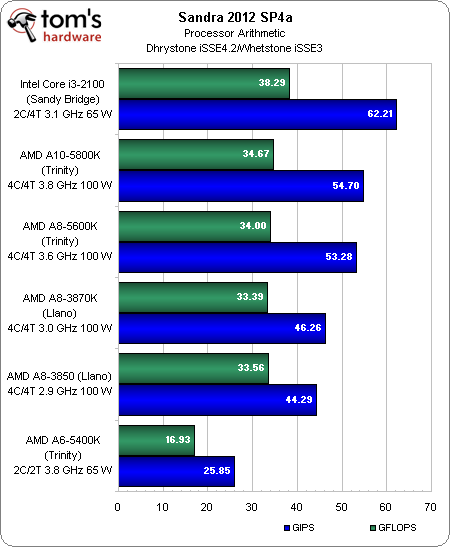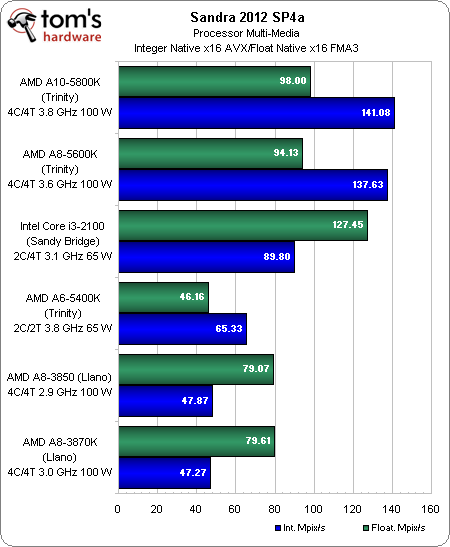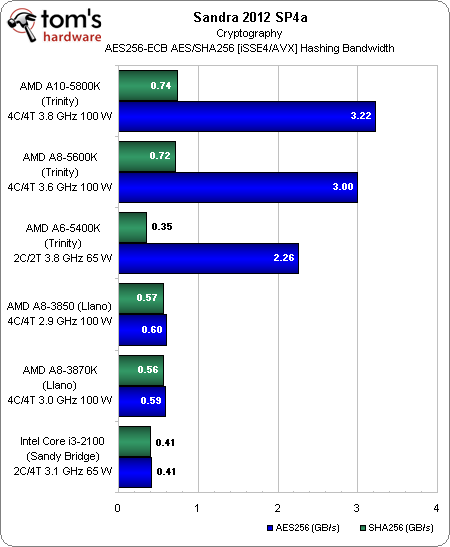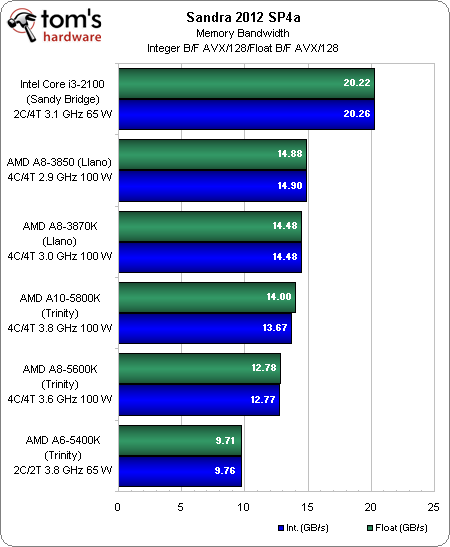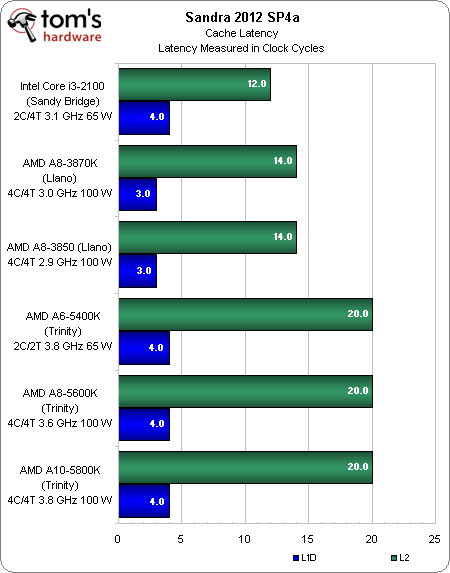AMD Desktop Trinity Update: Now With Core i3 And A8-3870K
Benchmark Results: Sandra 2012
At least on paper, Intel’s Core i3-2100 would seem to have an advantage in instruction per second throughput and floating-point operations per second. Whether Sandra’s synthetic measurements translate into real-world performance remains to be seen.
AMD demonstrates exceptional integer performance in the multi-media test, which we’d expect given its four physical integer cores. Floating-point performance suffers, though, due to the Piledriver architecture's shared resources, and Intel’s Core i3-2100 takes a first-place finish.
We didn’t point this out last time, but the twin Piledriver modules in A8 and A10 manage to deliver better FP performance than the four physical cores in both Llano-based contenders.
As part of its product differentiation strategy, Intel pulls AES-NI support from the Core i3s. Thus, you see its -2100 drag along at the bottom of our chart as all three Trinity-based APUs achieve respectable AES256 bandwidth.
No surprise—Intel’s dual-channel memory controller dramatically outperforms AMD’s best effort.
It is strange, though, that both Llano-based APUs push higher throughput than the three Trinity-based parts.
Core i3 takes the same L1 data cache hit as Trinity (compared to Llano), but its L2 latency is almost half of AMD’s upcoming APU. Llano’s L1D and L2 both appear to suffer less latency than Trinity, too.
Get Tom's Hardware's best news and in-depth reviews, straight to your inbox.
Current page: Benchmark Results: Sandra 2012
Prev Page Test Setup And Benchmarks Next Page Benchmark Results: Adobe CS5 And 6-
Belardo OOOPS!!Reply
And it still doesn't make sense to only reserve the best graphics for the high-end chips. People who want such performance in a desktop or notebook may likely have a dedicated GPU anyway.
The i3' should have HD graphics 3500/4000. -
mayankleoboy1 where are the OpenCL benchmarks ? specially in winzip ?Reply
if Intel cant run those, then technically its a loss for intel and win for AMD, right? -
Onus This gives me real hope that Piledriver will be a worthwhile chip to put on my 990FX rather than scrapping it for Intel as software becomes more demanding.Reply
I made myself read the entire article. I consider myself a literate person, but I still cannot find words to properly (and respectfully) express just how physically Beautiful your announcer is.
-
The video review girl is lovely, but being able to see her black brassier pushing her incredible breasts through that see-through shirt made me not pay attention at all to what she was talking about.Reply
-
ojas Hmmm...you think you could fix to them to the same clock rate and test one real-world productivity test? And perhaps one game with discrete graphics (maybe i've missed this particular test if you've already done it, if i have, sorry about that)...i mean with the i3 benchmarks for comparison.Reply
Apart from that, i think Trinity is clearly a win if AMD prices it the same as Llano. -
caqde I saw a Trinity Desktop from HP on Walmarts shelves. I just wish the processors and motherboards would show up at places like newegg so I could build them for people.Reply -
Reynod She did a good job getting the point across with the tech jargon.Reply
I'd like to see her doing some more short videos on various products.
She has improved with each new video too.
Good move Chris and team.
:) -
de5_Roy trinity's igpu humiliates intel's sb igpu, like llano's did almost a year back. all three are 32 nm products, so i think the comparison's fair. :) if the igpu was well-scalable, intel should have built a 85/95w sb core i3 with 20-30 eus to be competitive with the apus, at least in terms of igpu performance. if intel once again slaps hd 2500 on core i3s and overprices the hd4k + core i3s, trinity will win in terms of price/performance.Reply -
vmem REYNODShe did a good job getting the point across with the tech jargon.I'd like to see her doing some more short videos on various products.She has improved with each new video too.Good move Chris and team.Agreed, but she is also now completely covered up do to people "complaining". Would a low v-neck really be too much? She is overly covered compared to news anchorsReply
